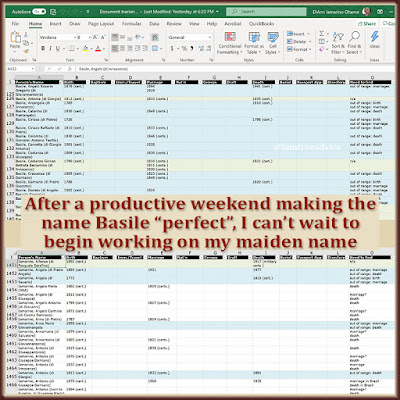Census sheets, ship manifests, birth, marriage and death records. These are the documents that bring your ancestors to life. Without them, you have no tangible evidence for your extended family.
The digital documents I collect are the heartbeat of my family tree. And I spend a good deal of time processing and caring for them.
My goal today is to get you thinking about how you handle your digital documents. What can you do to be more efficient? More thorough? More careful? More importantly, how can you make your family tree more valuable?
 |
| Careful work pays off in the form of a highly reliable family tree. |
Note that I have very few paper documents, and I've scanned them all into digital files. You won't find anything about color-coded binders and folders on this blog.
I have a vast collection of meticulously annotated, logically filed, safely backed-up documents. I make a habit of putting each new digital document through a series of steps. After downloading the digital document, I:
- Name the file in my usual style, which is most often LastnameFirstnameEventYear. For example, MartuccioMariaDeath1801.jpg. Note: I name census sheets and ship manifests for the head of the household or the traveling group.
- Crop the image in Photoshop to remove excess background or an unneeded facing page. Many old Italian birth and death records have 2 or more records in an image.
- Enhance the contrast so the document is easier to read, if necessary. Photoshop has a few good controls for this.
- Add a title and description to the document file's properties. These 2 field carry over when I drag and drop them into Family Tree Maker. I follow a pattern like this:
- Title: 1801 death record for Maria Martuccio
- Description: From the Benevento State Archives [followed by the exact URL of the image]
- Attach the image to the appropriate person(s) in Family Tree Maker. I turn the earliest image I have into a person's profile image.
- Create a source citation for each fact in the document.
- Add a notation to my document tracker spreadsheet so I know I've got this document.
- Keep the image file in a special folder, waiting for my weekly backup of all new files.
- Move the file to its final destination in my collection of digital family tree folders.
 |
| Annotated images tell you exactly where they came from. |
Yes, it's a lot, but it all serves my goal: To have the best family tree as a resource for anyone with roots in one of my ancestral hometowns. I want to be the absolute go-to family tree because of how carefully I document every fact in my tree.
Consider these ideas for your family tree document handling and care:
- 4 Important Steps for Each New Document lays out the same philosophy in an easy-to-follow flow.
- Get into a Groove to Fortify Your Family Tree gives you a simple way to think about, and follow, this practice.
- Can Your Genealogy Work Survive Without You? offers advice on preserving your genealogy research for future generations.
- How to Make Your Family Tree Fireproof! explains why I keep everything possible in digital form, and how to preserve it.
- 10-Minute Genealogy Tasks You Can Do helps you develop a discipline for handling your documents smartly. These tasks are a great way to make genealogy progress in small amounts of time.
What do you say? Is your family tree—your legacy—worth doing right?















